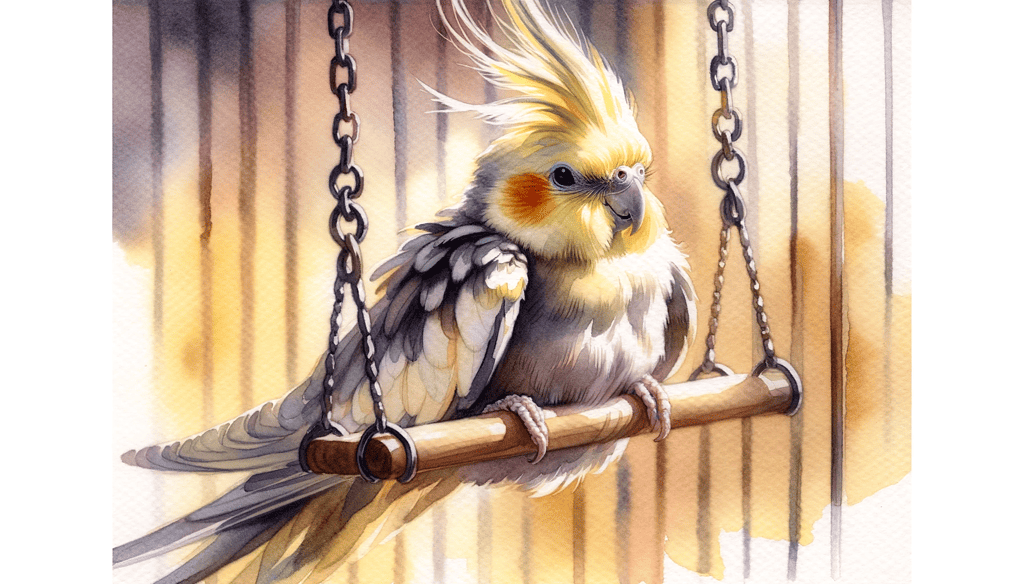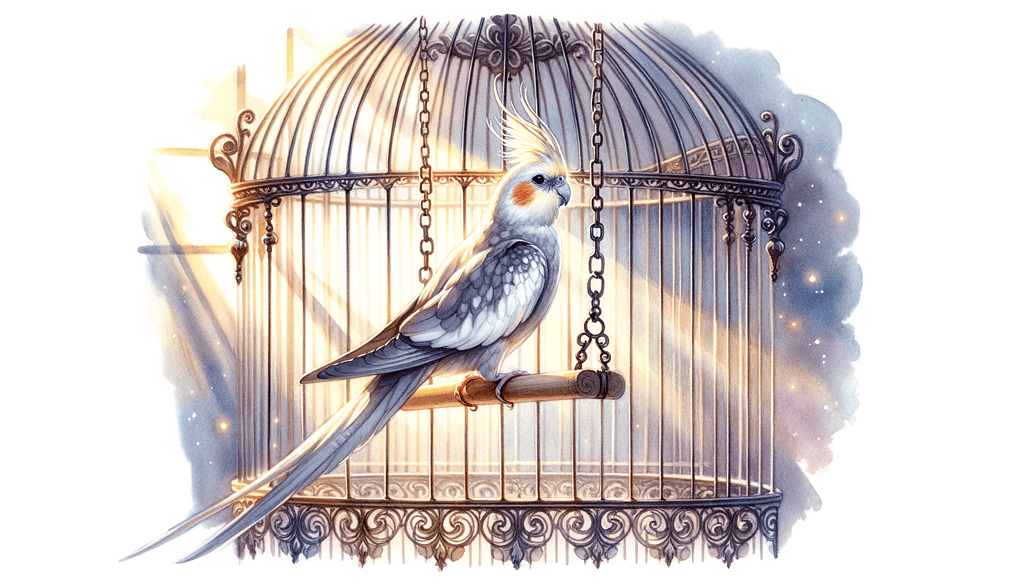
Cockatiels, with their playful nature and endearing personalities, have become a favorite among bird enthusiasts. But when it comes to their comfort and entertainment within their cages, do swings really make a difference?
As a whole, Swings are vital in a cockatiel’s environment, offering entertainment, exercise, and balance training. They simulate tree branch motions, providing cockatiels with a comforting sense of familiarity.
Dive deeper into the world of cockatiels and swings, and discover the myriad benefits and considerations every bird owner should be aware of.
Are Swings Good For Cockatiels?
As a veterinarian and observing countless cockatiels, I can confidently say that swings play a pivotal role in their well-being. Cockatiels, like many birds, thrive on stimulation and enrichment. Without it, they can easily become bored and even stressed. Swings, in particular, offer a unique form of enrichment that not only entertains but also provides a semblance of their natural habitat. In the wild, birds often perch on swinging branches, and this motion is something they’ve evolved to enjoy.
Benefits Of Swings For Cockatiels
Cockatiels, with their vibrant personalities and boundless energy, thrive when their environment is enriched with toys and activities. Swings, in particular, have become a favorite among these feathered friends. But why are swings and other toys so crucial for these birds?
Cockatiels are inherently energetic and active creatures. In the wild, they’re accustomed to flying between trees, hopping from branch to branch, and engaging in various activities that keep them mentally and physically stimulated. In captivity, however, their environment can be somewhat limited. This is where toys, especially swings, come into play.
Swings not only provide entertainment but also offer numerous benefits:
- Reminding of Nature: Swings mimic the motion of tree branches swaying in the wind, a natural phenomenon that cockatiels would experience in the wild.
- Exercise: As cockatiels use a bit of force to make the swing sway, they get a good workout, ensuring they stay healthy and in shape.
- Balance: Swings help improve a cockatiel’s balance, which is essential as they often relax and even sleep on one leg.
- Mental Stimulation: Just like humans, birds can get bored. Swings and other toys provide the necessary mental stimulation, preventing behavioral issues and depression.
Safety Concerns
As we delve deeper into the world of cockatiels and their toys, it’s essential to address the safety concerns that many bird owners have. After all, ensuring the well-being of our feathered friends is paramount.
Are Swings Dangerous For Cockatiels?
I can confidently say that swings are not inherently dangerous for cockatiels. However, like any other toy or accessory, it’s crucial to ensure they are used correctly. Cockatiels, with their playful nature, might occasionally appear clumsy, leading to minor tumbles off their swings. But don’t be alarmed; these little birds are quite adept at perching and usually recover quickly.
To ensure maximum safety:
- Place the swing inside their cage to prevent any significant falls.
- Ensure the swing’s height is appropriate, allowing the bird to access it comfortably without any strain.
- Regularly inspect the swing for any wear and tear, replacing it when necessary.
Table comparing the pros and cons of different swing placements within a cage.
| Swing Placement | Pros | Cons |
| Top of the cage | Provides a high vantage point; mimics natural tree-top perching | Risk of longer falls; might be challenging for some birds to access |
| Middle of the cage | Easily accessible; reduces risk of high falls | Might interfere with other cage accessories |
| Lower part of the cage | Minimizes fall height; suitable for older or less agile birds | Might not be as stimulating; could get dirty quickly |
What Type Of Swing Is Best For A Cockatiel?

The market offers a plethora of swing types for cockatiels, each with its unique features. Choose a swing made from bird-safe materials. The best swing largely depends on your cockatiel’s preferences and the cage setup.
However, some general guidelines can help you make an informed decision:
- Ensure the swing size is appropriate for your bird.
- Opt for natural materials like wood, which are safe and provide a more authentic perching experience.
- Avoid swings with small, detachable parts that could be a choking hazard.
Different materials commonly used in cockatiel swings:
- Wood: Natural, durable, and offers a comfortable grip.
- Rope: Flexible and soft, but ensure it’s made from safe, non-toxic fibers.
- Plastic: Easy to clean, but ensure it’s BPA-free and bird-safe.
- Metal: Durable and long-lasting, but ensure it’s coated to prevent rusting.
- Beads and bells: Add a playful element, but ensure they are securely attached.
Observing Your Cockatiel On A Swing
It’s a joy to watch cockatiels on swings, their playful antics, and the evident pleasure they derive from it. However, as a responsible bird owner, it’s essential to observe their behavior to ensure they are genuinely enjoying the experience and not facing any discomfort.
Table that contrasts signs of a happy cockatiel on a swing versus an uncomfortable one.
| Behavior | Happy Cockatiel | Uncomfortable Cockatiel |
| Vocalization | Cheerful chirping and singing | Distressed or loud squawking |
| Body Language | Relaxed posture; fluffed-up feathers | Ruffled feathers; aggressive or defensive posture |
| Interaction with Swing | Playful swinging and bobbing | Avoiding the swing or trying to escape |
| Eye Movement | Calm and curious gaze | Rapid eye movement or dilated pupils |
| Feather Condition | Smooth and well-preened | Constantly ruffled or showing signs of plucking |
Remember, every cockatiel is unique, and their behavior might vary. It’s essential to spend time with your bird, understand their personality, and ensure they have a comfortable and enriching environment.
Conclusion
In exploration of cockatiels and their affinity for swings, it’s clear that these playful accessories are more than just a source of entertainment. They contribute significantly to the physical and mental well-being of these charming birds, providing exercise, balance training, and a touch of their natural habitat. As we’ve explored various aspects of swings, from the benefits and safety concerns to the types and materials, it’s evident that a well-chosen swing can indeed bring joy and enrichment to a cockatiel’s life.
Did you find this article helpful? I’d love to hear your thoughts in the comments below. And if you know a fellow bird enthusiast who might benefit from this read, feel free to share the article with them!
Frequently Asked Questions
Do Cockatiels Like Toys?
Absolutely! Cockatiels are fun-loving and thrive when they have a variety of toys to interact with. From swings to boings, these toys not only entertain but also provide essential mental and physical stimulation.
What do cockatiels like in their cage?
Cockatiels enjoy having various items in their cage to keep them entertained and stimulated. They appreciate perches and swings, which not only provide them with zones for play but also mimic the motion of tree branches, giving them a sense of their natural habitat.
Why Do Cockatiels Like Swings?
Swings are fun and exciting. They provide a thrilling and fun experience, breaking the monotony of their cage. The motion of swings replicates the natural environment of cockatiels, evoking a sense of nostalgia and comfort.
